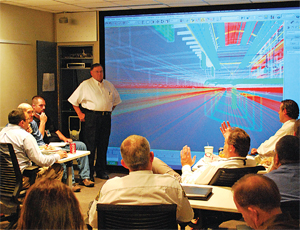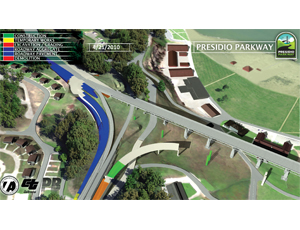Virtual design and construction is the topic of a new professional certification program at Stanford University’s Center for Integrated Facilities Engineering (CIFE). But it’s not so much about 3-D modeling, software, hardware or magical visualizations as it is about an integrated approach to linking all the tools at your disposal, including data-driven design and organization and decision process modeling. The course teaches that VDC isn’t a tool but a framework that leverages an array of technology to accomplish superior work.

“It’s about how you make that idea happen,” explains recent graduate Sagar Gandhi, Southern California BIM leader for DPR Construction Inc., Newport Beach, Calif. He says the course is not about any specific software at all. “It’s about the way we are thinking, and by the end of it [the students] understand you have to be collaborative...with all the stakeholders.”
CIFE’s VDC approach requires cross- discipline collaboration. Students are taught to integrate into the design process from the outset as many stakeholders from throughout the facility life cycle as possible. A broad range of stakeholders have been enrolling since the program started gathering steam a year ago.
The first 17 graduates were awarded certificates on Aug. 25. Several companies—like DPR, which took five seats—had multiple people enrolled. Their titles, and those of the new group of 16 now beginning a new session, cover many facets of construction.
“We have had building owners, architects, engineers, GCs, subs, suppliers and VDC service providers,” says Martin Fischer, CIFE director. “We’ve had presidents, VPs, directors, project executives, project managers, superintendents, project engineers and IT specialists.”
Fischer is one of the instructors. Others are John Kunz, CIFE executive director, and Roberto Arbulu, director of technical services at Strategic Project Solutions Inc., San Francisco, who helped plan and deliver the course. “To our knowledge, this is a first in the world,” says Fischer.
Because the course is for professionals, its students “learn by doing,” Fischer says. “We want the individuals, projects and companies to reap benefits ASAP.”
The course starts with a week on campus to school participants on the material and get them thinking differently about project organization, design and management methods, as well as technology.
Participants return to their workplaces after the week to implement VDC on a project and capture performance metrics. Then, over the next six to 12 months, depending on their projects, they meet on monthly calls to discuss problems, share discoveries and describe progress. The course ends in a two-day session back at Stanford to present findings and help participants plan their next VDC deployments at their companies.
There are benefits for regular students in Stanford’s graduate and undergraduate programs. Although they are not directly involved, Fischer says a lot of the material in the VDC program comes out of graduate-level courses, and feedback from the professionals flows the other way, improving the material on both sides. He adds that, ultimately, regular students also will benefit after graduation when they find managers who are in tune with the VDC methods championed by CIFE.
Results Delivered
Brendan Robinson, who says he is the only owner to graduate from the course and be certified, is a project manager at the Duke University Health System Office of Facility Planning, Design and Construction in Durham, N.C. He says Duke FPDC previously had consultants using models for visualization and clash detection, but it didn’t have firm opinions or best practices about how models could be used on projects to add value. “One of my goals in attending was to understand how these methods could help us improve performance in delivering a capital project,” he says. “The course gave me just what I was looking for.”
Robinson cites several good results, including how VDC-style integrated concurrent engineering sessions around 3-D models with doctors and nurses—the stakeholders of hospital projects—paid off in faster design and...



Post a comment to this article
Report Abusive Comment